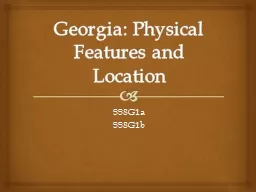PPT-Georgia: Physical Features and Location
Author : cheryl-pisano | Published Date : 2018-10-23
SS8G1a SS8G1b SS8G1 The student will describe Georgia with regard to physical features and location a Locate Georgia in relation to region nation continent and hemisphere
Presentation Embed Code
Download Presentation
Download Presentation The PPT/PDF document "Georgia: Physical Features and Location" is the property of its rightful owner. Permission is granted to download and print the materials on this website for personal, non-commercial use only, and to display it on your personal computer provided you do not modify the materials and that you retain all copyright notices contained in the materials. By downloading content from our website, you accept the terms of this agreement.
Georgia: Physical Features and Location: Transcript
Download Rules Of Document
"Georgia: Physical Features and Location"The content belongs to its owner. You may download and print it for personal use, without modification, and keep all copyright notices. By downloading, you agree to these terms.
Related Documents














